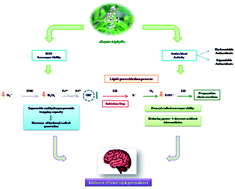The protective effect of Aloysia triphylla aqueous extracts against brain lipid-peroxidation
Abstract
In a normal diet, the use of herbs may contribute significantly to the total intake of plant antioxidants and even be a better source of dietary antioxidants than many other food groups. Therefore, the aims of this study were to evaluate the protective effect of aqueous extracts of Aloysia triphylla (infusion and decoction) against lipid-peroxidation of brain homogenates and to determine changes in the prooxidant/antioxidant balance when the plant material is added. In order to elucidate a possible antioxidant mechanism in vitro evaluation of total antioxidant capacity, oxygen species scavenging ability and reducing power (RP) were studied. Tested extracts had shown a strong inhibition of lipid-peroxidation measured as thiobarbituric acid-reactive products of lipid-peroxidation (TBARS) and chemiluminescence. Furthermore, infusion and decoction exhibited free radical trapping ability, expressed by the capacity to scavenge superoxide and hydrogen peroxide. Additionally, both aqueous extracts presented antioxidant activity measured as total reactive antioxidant potential (TRAP), 1,1-diphenyl-2-picrylhydrazyl radical (DPPH) and 2,2′-azino-bis(3-ethylbenzthiazoline)-6-sulfonic acid radical (ABTS) scavenging activity and RP. These results suggest that the lipid-peroxidation inhibition mechanism proposed is that the antioxidants present in Aloysia triphylla could act as strong scavengers of reactive oxygen species not only at the initiation of the lipid-peroxidation chain reaction, but also at the propagation step. Therefore, they could be used as prophylactic and therapeutic agents for those diseases where the occurrence of oxidative stress and lipid-peroxidation contributes to the progression of damage.


 Please wait while we load your content...
Please wait while we load your content...